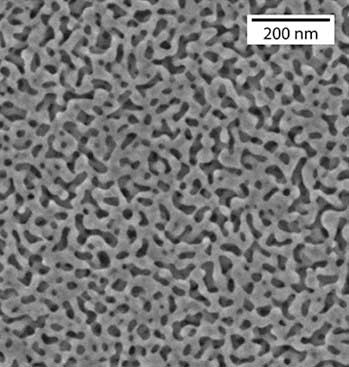
Thursday, May 3, 2018
A designer's toolkit for constructing complex nanoparticles
A team of chemists has developed a designer's toolkit that lets them build various levels of complexity into nanoparticles using a simple, mix-and-match process.
Atomically thin magnetic device could lead to new memory technologies
Researchers have encoded information using magnets that are just a few layers of atoms in thickness. This breakthrough may revolutionize both cloud computing technologies and consumer electronics by enabling data storage at a greater density and improved energy efficiency.

Mining for nanogold with a computer
Engineers report important new insights into nanoporous gold--a material with growing applications in several areas, including energy storage and biomedical devices--all without stepping into a lab.

Harvesting clean hydrogen fuel through artificial photosynthesis
A new, stable artificial photosynthesis device doubles the efficiency of harnessing sunlight to break apart both fresh and salt water, generating hydrogen that can then be used in fuel cells.

Picking one photon out of the flow
Researchers have discovered a way to subtract a single quantum of light from a laser beam.

Morphing twisted nanoscale objects to tailor applications in future technologies
For the first time scientists have created a way to model the interaction between light and twisted molecules, as these molecules transition from left- to right-handed versions.

Long-distance relationships of particles: Electron-hole pairs in two-dimensional crystals
Scientists reveal the nature of optical excitations in two-dimensional crystals within an international collaboration.

Cell membrane inspires new ultrathin electronic film
Researchers have developed a new method to build large areas of semiconductive material that is just two molecules thick and a total of 4.4 nanometers tall. The films function as thin film transistors, and have potential future applications in flexible electronics or chemical detectors.

Chemists develop MRI-like technique to detect what ails batteries
A team of chemists has developed an MRI-based technique that can quickly diagnose what ails certain types of batteries--from determining how much charge remains to detecting internal defects--without opening them up.

Custom silicon microparticles dynamically reconfigure on demand
First demonstration of self-assembling and self-disassembling silicon microparticles could form the basis for designing artificial muscles and reconfigurable computer systems.

Controlling the crystal structure of gallium oxide
Precise control of the atomic structure of gallium-oxide layers improves the development of high-power electronic devices.

Ultrafast atomic snapshots reveal energy flow in superconductor
Scientists have measured the intricate interactions between atomic nuclei and electrons that are key to understanding intriguing materials properties, such as high-temperature superconductivity.

Lining MOF pockets to detect noxious gases
Custom-made gas-sensing material could lead to inexpensive devices for real-time air quality analysis.

Topological domain walls in helimagnets
Three distinct variants of magnetic domain walls have been discovered in the helimagnet iron germanium (FeGe).

Subscribe to:
Posts (Atom)
